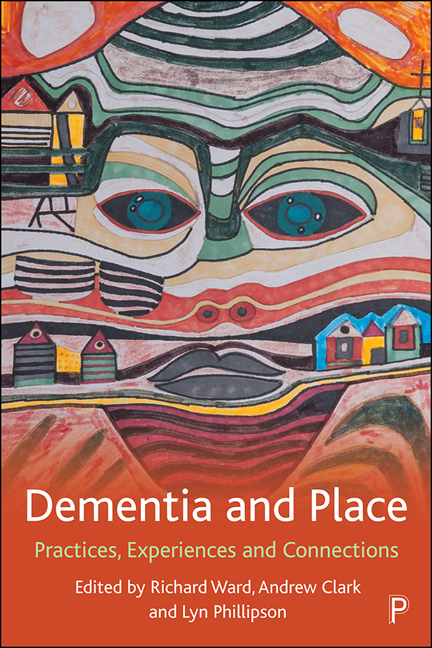Book contents
- Frontmatter
- Dedication
- Contents
- List of figures and tables
- Notes on contributors
- Acknowledgements
- 1 Introduction: Placing dementia
- 2 Understanding the meaning of neighbourhoods for people living with dementia: the value of a relational lens
- 3 Moving house with dementia
- 4 How do people with dementia manage problematic situations in public spaces?
- 5 Making and maintaining neighbourhood connections when living alone with dementia
- 6 My neighbourhood, my future ...?
- 7 Enabling the neighbourhood: a case for rethinking dementia-friendly communities
- 8 A conceptual framework of the person– environment interaction in the neighbourhood among persons living with dementia: a focus on out-of-home mobility
- 9 We’re known as ‘the girls’ around town: support, isolation and belonging for a lesbian couple living with dementia
- 10 Building community capacity for dementia in Canada: new directions in new places
- 11 The good, the challenging and the supportive: mapping life with dementia in the community
- 12 Growing back into community: changes through life with dementia
- 13 Dementia, tourism and leisure: making the visitor economy dementia friendly
- 14 Conclusion: Dementia emplaced
- Index
2 - Understanding the meaning of neighbourhoods for people living with dementia: the value of a relational lens
Published online by Cambridge University Press: 13 May 2022
- Frontmatter
- Dedication
- Contents
- List of figures and tables
- Notes on contributors
- Acknowledgements
- 1 Introduction: Placing dementia
- 2 Understanding the meaning of neighbourhoods for people living with dementia: the value of a relational lens
- 3 Moving house with dementia
- 4 How do people with dementia manage problematic situations in public spaces?
- 5 Making and maintaining neighbourhood connections when living alone with dementia
- 6 My neighbourhood, my future ...?
- 7 Enabling the neighbourhood: a case for rethinking dementia-friendly communities
- 8 A conceptual framework of the person– environment interaction in the neighbourhood among persons living with dementia: a focus on out-of-home mobility
- 9 We’re known as ‘the girls’ around town: support, isolation and belonging for a lesbian couple living with dementia
- 10 Building community capacity for dementia in Canada: new directions in new places
- 11 The good, the challenging and the supportive: mapping life with dementia in the community
- 12 Growing back into community: changes through life with dementia
- 13 Dementia, tourism and leisure: making the visitor economy dementia friendly
- 14 Conclusion: Dementia emplaced
- Index
Summary
Introduction
This chapter explores what neighbourhoods mean for people living with dementia. While the built environment, and the economic and political apparatus they comprise of such as shops, services and localised campaigning, are certainly important, our attention focuses on how people living with dementia understand neighbourhoods as sites of relationally constituted ordinary or everyday social connection, engagement and interaction. The chapter outlines the nature of associations individuals have with the wider social sphere of their immediate locale and considers how these ostensibly geographical proximate (or local) social connections might support people to live as well as they might with dementia. In doing so, it considers why it matters to understand the socio-spatial dimensions of neighbourhoods as relational and interconnected phenomena and considers the importance of thinking about neighbourhoods as more than environments in need of intervention or modification in order to support people living with dementia.
How are neighbourhoods understood in the dementia literature?
In a review published in 2012, Keady and colleagues noted that a surprisingly small amount of literature has focused specifically on the importance of neighbourhoods for people living with dementia. The review identified three domains of activity: outdoor spaces, the built environment, and everyday technologies. The first examines how the outdoor environment can be better designed and/or modified to support people living with dementia. This includes work on the design of streetscapes and road layouts to better support mobility, as well as ongoing work to enable easier access to a range of different environments such as green and recreational spaces. A second attends to navigation and mobility of environments, such as shopping centres, hospitals, museums and grocery stores. The third investigates the use of technologies, including virtual realities, to support access to, or better develop, environments beyond the home (Keady et al, 2012). Since then, a considerable body of work has continued to investigate these areas (Sturge et al, 2021) and continues to provide evidence of the need to better understand why and how people living with dementia interact with their immediate environments outside of the home.
- Type
- Chapter
- Information
- Dementia and PlacePractices, Experiences and Connections, pp. 23 - 43Publisher: Bristol University PressPrint publication year: 2021



